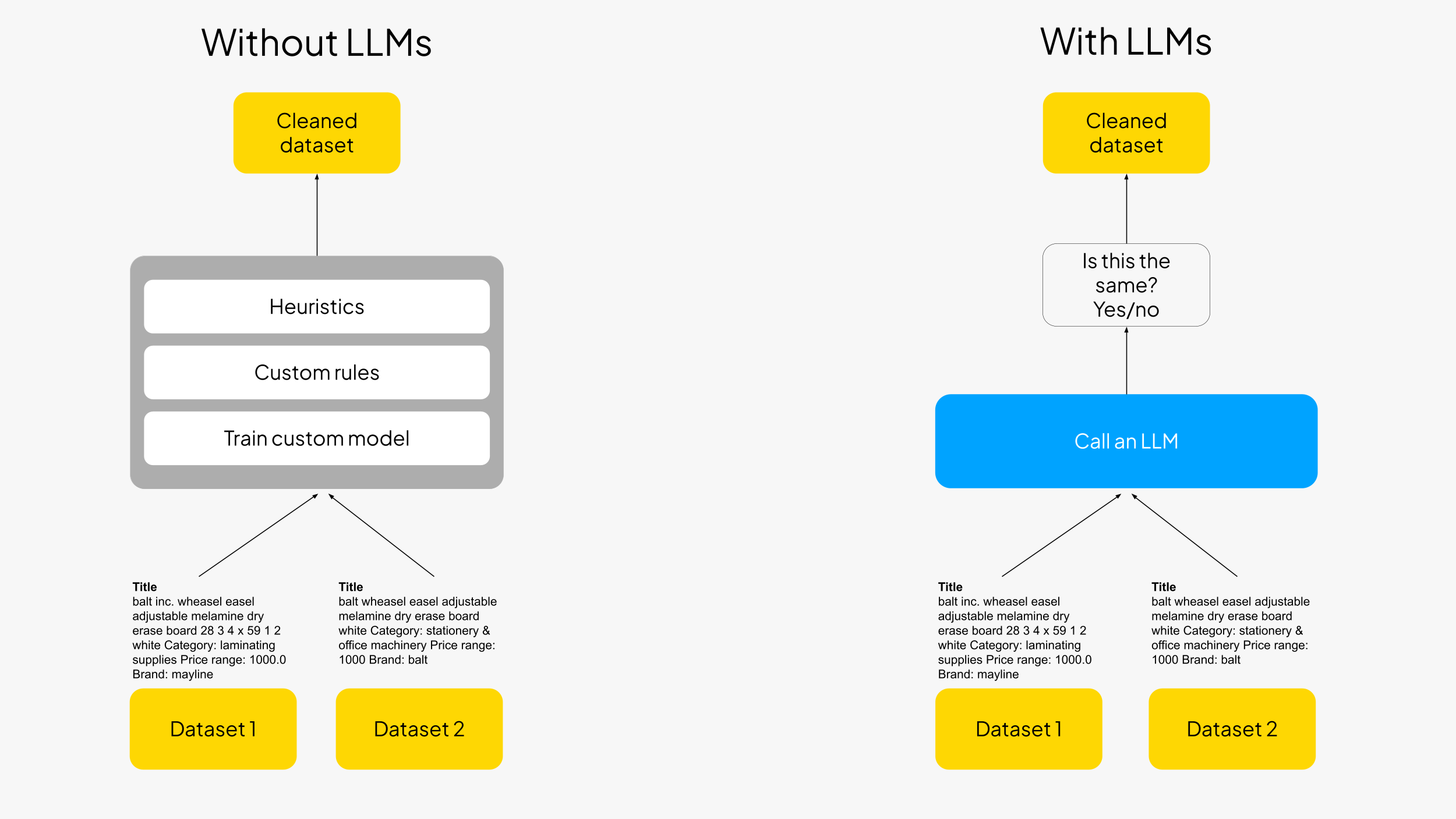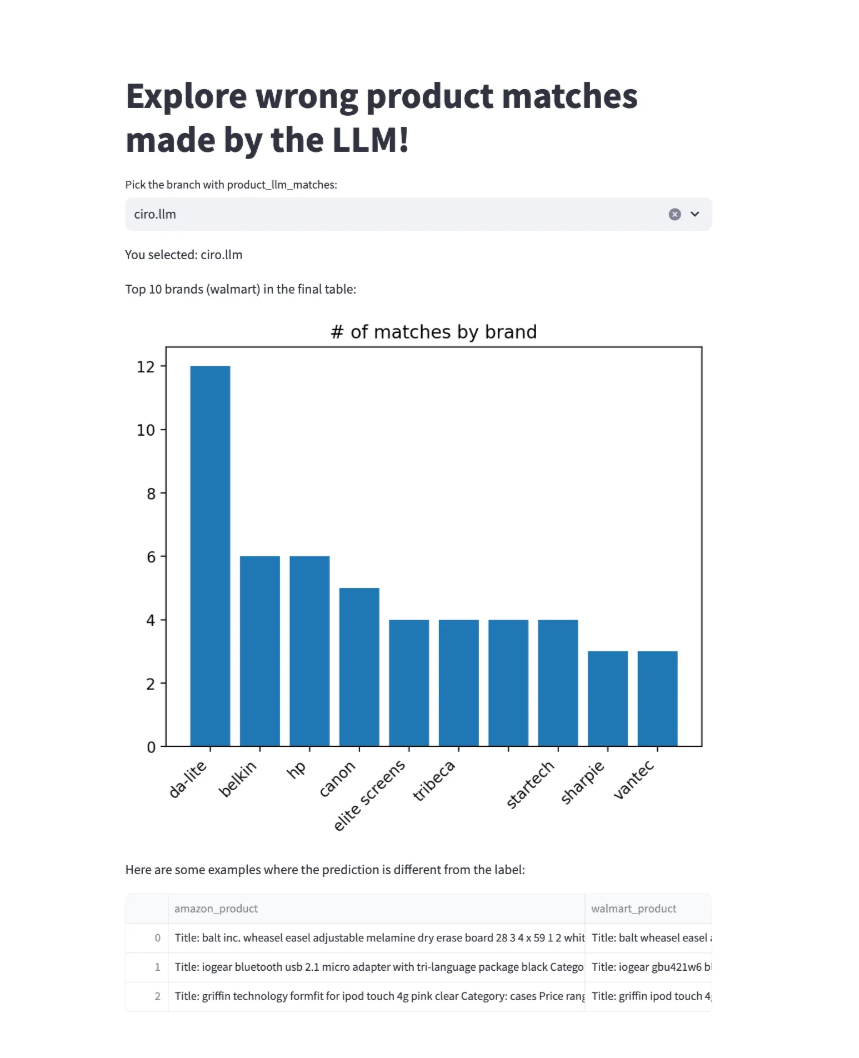Entity matching with OpenAI¶
Overview¶
This example demonstrates an end-to-end entity matching pipeline for e-commerce, combining Bauplan for seamless data preparation with OpenAI’s off-the-shelf LLM APIs for accurate matching.
Entity Matching (EM) is a common yet often tedious challenge for data scientists. It involves identifying pairs of entries across datasets that represent the same real-world entity—such as products, publications, people, or businesses. For instance, in e-commerce, the same product can be listed with different names, descriptions, and prices across different websites.
Historically, Entity Matching (EM) has been a challenging task, often involving complex data structures like graphs and a mess of manual rules, heuristics, and hyper-specific model tuning for each dataset and task.
Large Language Models (LLMs) offer a more flexible and generalized approach. The concept, originally pioneered by Chris Ré’s lab, has gained increasing traction lately.
The key advantage of using LLMs for EM is the dramatic simplification of pipelines. Instead of having to take care of training custom models, build pipelines with manual rules, define dataset and task specific heuristics, we can just call an LLM and use it as a pre-trained general classifier. This can easily translate in getting rid of thousands of lines of ad hoc code.

The project¶
We are going to use the the Wallmart-Amazon dataset comes from the DeepMatcher website, which contains product information from the Amazon and Walmart product catalogues. Given the two product catalogs, we want to match the products that are the same across the two datasets.
We build a bauplan pipeline to prepare the data for entity matching, and then use an off-the-shelf LLM API to perform the matching: the entire project runs end-to-end on object storage (S3), in open formats (Iceberg), using nothing else than vanilla Python code to orchestrate the DAG and integrate AI services.
We finally build a small Streamlit app to explore the predictions made by the LLM model, leveraging again the pure Python APIs from bauplan.
In the end-to-end example, the data flow as follows between tools and environments:
The original dataset is stored in three Iceberg tables: one table for Walmart, one for Amazon, and one as a test set to simulate an application request for matches. All the datasets are available in bauplan sandbox in the
publicnamespace;The pipeline in
examples/07-entity-matching-with-llm/bpln_pipelinecontains the data preparation and training steps as simple decorated Python functions. Running the pipeline in bauplan will execute these functions and store the result of entity matching for the test dataset in a new, “big” table.The Streamlit app in
src/appshowcases how to get back the matches using bauplan and visualize them in a simple web interface

The pipeline¶
The data pipeline processes raw data from the Amazon and Walmart tables by creating new tables where the original columns (id, title, category, price, brand) are combined into a single serialized field.
These serialized tables, along with the public.matching_products table, are then fed into the final node, which identifies product matches using the serialized product information and LLM calls.
Setup¶
Python environment¶
To run the project, you need to have Python >=3.10 installed. We recommend using a virtual environment to manage dependencies:
python3 -m venv venv
source venv/bin/activate
pip install -r requirements.txt
bauplan¶
Join the bauplan sandbox, sign in, create your username and API key.
do the 3-min tutorial to get familiar with the platform.
Open AI¶
Sign up on OpenAI to get your API key — you’re free to experiment with different LLMs by simply replacing the LLM utility code in the pipeline.
Run the project¶
Check out the dataset¶
Using bauplan, it is easy to get acquainted with the dataset and its schema:
bauplan table get public.amazon_products
bauplan table get public.walmart_products
bauplan table get public.matching_products
Note for example that public.matching_products contains three columns: the product id from the Walmart product catalog, the product id from the Amazon product catalog, and a label indicating whether the two products are the same or not.
This table will be used to simulate an application request for matches. The column label will be used to evaluate the performance of the LLM model as the ground truth.
You can quantify the test set imbalance with a simple query directly in your CLI:
bauplan query "SELECT label, COUNT(*) as _C FROM public.matching_products GROUP BY 1"
Run the pipeline with bauplan¶
Create a data branch to develop your application.
cd src/bpln_pipeline
bauplan branch create <YOUR_USERNAME>.product_matching
bauplan branch checkout <YOUR_USERNAME>.product_matching
Now, add your OpenAI key as a secret to your project: this will allow bauplan to connect OpenAI securely:
bauplan parameter set --name openai_api_key --value aaa --type secret
If you inspect your bauplan_project.yml file, the new parameter will be found:
parameters:
openai_api_key:
type: secret
default: kUg6q4141413...
key: awskms:///arn:aws:kms:us-...
You can now run the DAG:
bauplan run
Running the DAG will create a new table in your data lake branch names product_llm_matches. You can check the schema of the new table with the following command:
bauplan table get product_llm_matches
Exploring LLM mistakes in Streamlit¶
We can visualize the predictions easily in any Python environment, using the bauplan SDK library to interact with the tables we built by running our pipeline. We provide a simple Streamlit app to do so.
To run the app:
cd src/app
streamlit run explore_matches.py -- --bauplan_user_name <YOUR_USERNAME>
The app will open in your browser, and you can start exploring the predictions made by the LLM model vs the ground truth we have in the test set: feel free to modify the query in the app to slice and dice the data as you see fit (e.g. can you restrict the result for a certain category only?).
Where to go from here?¶
The prompts used in this project come from here and could definitely use some improvement. How can you update the LLM code to leverage the latest LLM capabilities?
Calling OpenAI APIs sequentially may be too slow. Since bauplan supports arbitrary dependencies into your functions, it could be useful to use multi-threaded processes to parallelize the calls and speed up the pipeline.
License¶
The code in this repository is released under the MIT License and provided as is.